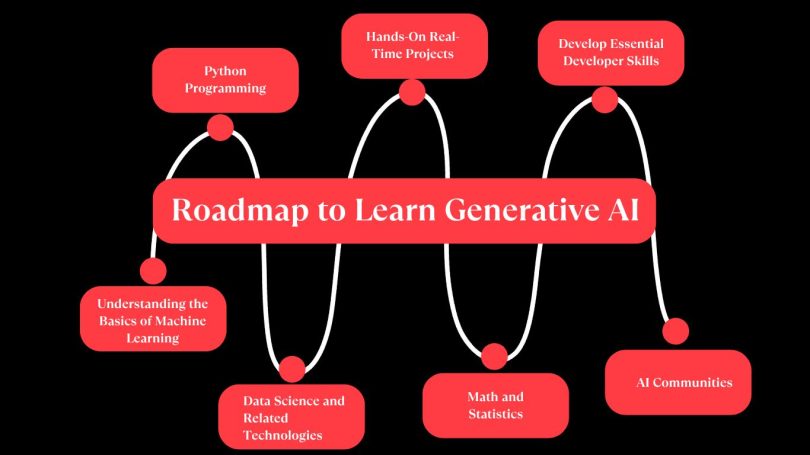Generative AI
It is a branch of artificial intelligence focused on teaching machines to use existing data to create new data. Compared with AI in the past which mostly concerned with the classification of data, generative AI is able to create new text formats, pictures, videos or even codes.
Let’s get ready to explore the world of generative AI because the future is as bright as it has never been before. This is the guide to becoming an expert in generative AI.
Generative AI: A Roadmap for Learning
Understanding the Basics of Machine Learning
- First, let’s briefly go over the key machine learning algorithms, each of which is designed to solve a specific problem.
- Know supervised, unsupervised and reinforcement learning as being similar to understanding various strategies for solving a puzzle.
- Learn how to manipulate data, which is a significant aspect of models, such as cleaning data, splitting data, and preprocessing it.
- It is also important that you learn how to measure the models with other parameters like accuracy and precision to check the strength of the model.
Python Programming
- Be familiar with the syntax and structure of Python, the language that is widely used in artificial intelligence.
- Learn about recommended libraries for AI, including Pandas for data processing and Scikit-learn for machine learning, which are key tools for model creation.
- Get into the habit of writing clean code to ensure that the performance of the code is as good as possible.
- To remain informed on the latest developments in the Python world, it is recommended to communicate with other Python users.
Data Science and Related Technologies
- Study how to use data visualization techniques to identify trends and gain valuable business insights.
- Expertize feature engineering to turn the raw data collected into a format that is easily understandable and easily predictable by machines.
- Experience how to create a pipeline that works similarly to an assembly line to process raw data for machine learning.
- It is crucial to keep up to date with the new technologies and frameworks in data science that are used in conjunction with generative AI to remain ahead of the competition.
Hands-On Real-Time Projects
- Choose projects that you find interesting/exciting and which pose some level of difficulty.
- Use all the knowledge gained in the previous lessons and practice with different generative AI models to strengthen your understanding and improve your skills.
- In other words, constantly improve your projects, as every iteration will take you one step closer to perfecting your craft.
- Make sure to organize and share your work effectively as a way of showcasing your improvement and accomplishments.
Math and Statistics
Mathematics and statistics are critical to the understanding of AI and machine learning since they form the basis of the algorithms involved. Go through the linear algebra and calculus lessons as these are important for understanding how AI models learn and make predictions.
Probability and statistics are the two key areas which help in understanding the uncertainty and making predictions. Learn about model optimization, which is fundamental to enhancing models as they progress, as it is to learning from errors and applying the knowledge to perform better.
Develop Essential Developer Skills
It is crucial to become familiar with AI development tools that can increase your work’s productivity, speed and cohesiveness. Emphasize debugging and testing, as while working with theoretical models, they can have issues in real-life scenarios.
Ethical AI is the best way to ensure that the AI solutions you are developing are ethical in their operations. Also, stay open-minded as the field of AI is vast and is in constant development.
AI Communities
Staying updated with the latest advancements and theories in AI requires regularly reading research papers, blogs and books. This is because one can get ideas and learn about new technologies from the various workshops and conferences that are held. It is recommended to find a mentor or work on projects together because it is always faster to learn from others and expand the possibilities.
Following this roadmap, you will be ready to face the challenges and opportunities of the rapidly developing field of generative AI in 2024.
Conclusion
The possibilities of generative AI are not limited to code alone but are a spark that can create a future filled with creativity beyond and very far from imagination. This technology enables machines to generate new images, text styles and even music from scratch by feeding them large datasets. It is the power behind every mesmerizing deepfake video, virtual influencer, and potentially the next big chart-topping song. While you are setting off on this exciting adventure to become a master in generative AI by 2024, this roadmap provides you with the right strategies. From mastering the basics of machine learning and Python to working on real-time projects and enhancing your developer skills, you will be on the right track to becoming an expert. Just as a reminder, the road to mastery is not a solitary one, but rather a lifelong process of learning and sharing.






Leave a Comment